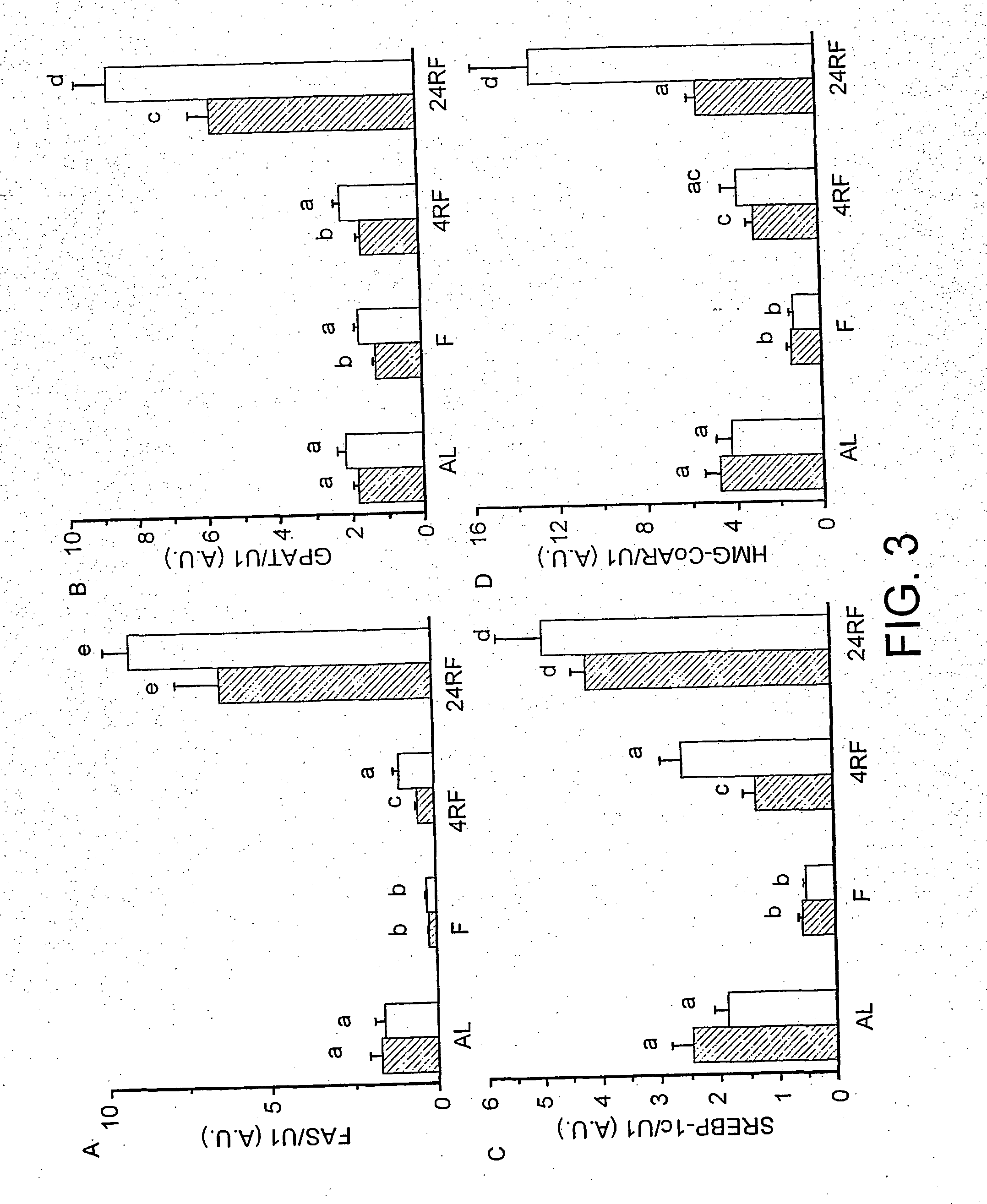Lipid profile modulation
a lipid profile and lipid technology, applied in the digestive system, metabolism disorder, endocrine system disorder, etc., can solve the problems of reducing the prevalence of coronary heart disease, cigarette smoking and metabolic syndrome still constitute significant risk factors, and other risk factors are believed to become increasingly atherogenic, so as to achieve an altered cardiovascular risk profile
- Summary
- Abstract
- Description
- Claims
- Application Information
AI Technical Summary
Benefits of technology
Problems solved by technology
Method used
Image
Examples
example 1
[0186] 11βHSD-1− / − Mice Have Lower Plasma Triglyceride and Higher HDL Cholesterol
[0187] Plasma triglycerides are lower in ad lib fed 11βHSD-1 null mice (FIG. 1A). A representative FPLC profile of ad lib ‘true’ triglycerides (FIG. 1B) indicated that glycerol interference does not account for the differences between genotype. Triglycerides clearly fall upon fasting in both genotypes. Two way ANOVA indicated that the reduction in triglycerides in 11βHSD-1− / − mice upon fasting is significantly smaller in magnitude compared to wild type (FIG. 1A). However, whilst wild-type triglyceride levels returned to ad lib fed values by 24 hours of re-feeding, 11βHSD-1− / − triglyceride values returned to ad lib values by 4 hours and exhibited an overshoot to levels significantly higher than the ad lib fed group at 24 hours. Total and HDL cholesterol did not vary significantly with dietary manipulation (FIG. 2A and 2B). However, there is a highly significant effect of genotype, with 11βHSD-1− / − mice ...
example 3
[0194] 11βHSD-1− / − Mice Show Attenuated Induction of Glucocorticoid-sensitive Transcripts with Fasting
[0195] Fasting causes a 2 fold induction of PPARα in wild type mice (FIG. 4D), consistent with reports that this transcription factor mediates glucocorticoid-induced fatty acid oxidation during fast (20, 21). However, whilst 11βHSD-1− / − liver PPARα levels are higher than wild type levels during ad lib fed conditions, fasting induction of PPARα mRNA is abolished in 11βHSD-1− / − animals (FIG. 4D). Despite the abolished induction of PPARα, the downstream target genes ACO and UCP-2 showed a fasting induction. This induction is smaller relative to the wild type ad lib to fasting induction. Such a modest induction could reflect the presence of relatively elevated ad lib fed PPARα levels in mice being activated by the increased levels of endogenous PPARα activators, fatty acids, during fasting. The glucocorticoid-inducible transcript apoAI also shows an attenuated rise on fasting, compatib...
example 4
[0197] 11βHSD-1 Mice Have Increased Hepatic Insulin Sensitivity Upon Re-feeding After Fast
[0198] We have investigated hepatic insulin sensitivity by assessing the relative changes in insulin-sensitive transcript levels upon re-feeding after a 24 hour fast. Northern analysis shows that insulin repressible transcripts such as CPT-I and UCP-2 are more markedly suppressed in 11βHSD-1− / − mice (FIG. 4A and 4C) upon re-feeding. Conversely, insulin-inducible transcripts, such as those in the lipogenic (SREBP-1, FAS, GPAT) and cholesterologenic (HMG-CoAR) pathways, are more markedly induced in 11βHSD-1− / − mice upon re-feeding (FIG. 3A-D).
[0199] 11βHSD-1− / − mice have improved glucose tolerance—Studies of dynamic glucose disposal indicate that 11βHSD-1− / − mice have improved glycaemic control (FIG. 8). Taking into account the reduced zero-time glucose levels in the 11βHSD-1− / − mice after fasting which likely reflects the attenuated stress reaction in fasting glucose production (16), area unde...
PUM
| Property | Measurement | Unit |
|---|---|---|
| temperature | aaaaa | aaaaa |
| concentrations | aaaaa | aaaaa |
| concentration | aaaaa | aaaaa |
Abstract
Description
Claims
Application Information
 Login to View More
Login to View More - R&D
- Intellectual Property
- Life Sciences
- Materials
- Tech Scout
- Unparalleled Data Quality
- Higher Quality Content
- 60% Fewer Hallucinations
Browse by: Latest US Patents, China's latest patents, Technical Efficacy Thesaurus, Application Domain, Technology Topic, Popular Technical Reports.
© 2025 PatSnap. All rights reserved.Legal|Privacy policy|Modern Slavery Act Transparency Statement|Sitemap|About US| Contact US: help@patsnap.com



